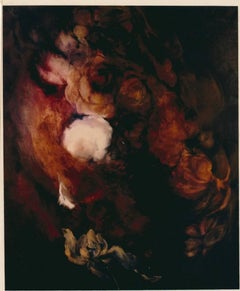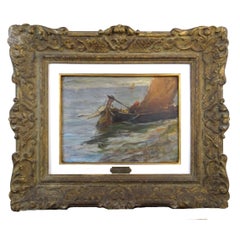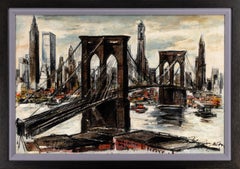Anna Ramenghi Art
to
1
Overall Width
to
Overall Height
to
1
1
1
1
1
1
1
1
1
1
1
1
10,043
2,758
1,381
1,375
1
Artist: Anna Ramenghi
Flower of Eros
By Anna Ramenghi
Located in Roma, IT
Hand Signed overleaf.
Category
1990s Modern Anna Ramenghi Art
Materials
Oil, Canvas
Related Items
Painting 'Vela' P. Fragiacomo, circa 1910s
By Pietro Fragiacomo
Located in Vicenza, VI
Oil painting on panel by artist P. Fragiacomo, dating from the 1910s.
The work, titled "Sail," depicts a small sailboat in the middle of the sea with a figure on board seen from behi...
Category
Early 1900s Modern Anna Ramenghi Art
Materials
Canvas, Oil
$1,196
H 9.06 in W 12.21 in D 0.4 in
John Haymson "Brooklyn Bridge" Oil Painting of New York Skyline, circa 1955
By John Haymson
Located in Miami, FL
JOHN HAYMSON – "BROOKLYN BRIDGE"
⚜ Oil on Canvas ⚜ Hand Signed ⚜ Conservation Frame
NEW YORK ICON IN VIVID DETAIL
This atmospheric oil painting by John Haymson captures the enduring...
Category
1950s Modern Anna Ramenghi Art
Materials
Canvas, Oil
$4,000
H 28.625 in W 40.625 in D 1.375 in
The Artist's Wife oil painting by Hans Burkhardt
By Hans Burkhardt
Located in Hudson, NY
Hans Burkhardt
The Artist's Wife (1930)
Oil on canvas, 20" x 16"
24" x 20 ½" x 1 ½" framed
Dated 1930 lower right recto. Annotated "To Elsa HB Louise Burkhardt 1930. HB" verso.
...
Category
1930s American Modern Anna Ramenghi Art
Materials
Canvas, Oil
1960s Italian Signed Still Life With Flowers
Located in Roma, IT
1960s Italian Signed Still Life With Flowers
A beautiful and rare painting by one of Italy's most important avant-garde artists.
It depicts a stunning vase of flowers with intense, ...
Category
1950s Modern Anna Ramenghi Art
Materials
Canvas, Oil
$3,589
H 24.02 in W 20.48 in D 3.15 in
“The Big City, 1948” Grand Central Station NYC Manhattan Female WPA Modernist
Located in Yardley, PA
“The Big City, 1948” by Anna Elkan Meltzer (American, 1896-1974)
One of Meltzer’s finest works, this painting encapsulates the organized chaos of Grand Central Terminal in NYC in th...
Category
1940s American Modern Anna Ramenghi Art
Materials
Oil, Canvas
$12,000
H 33.38 in W 28.38 in D 2.5 in
Fish Story oil painting by Williams Charles Palmer
Located in Hudson, NY
This painting is illustrated in the Catalogue of the 1945 Encyclopedia Britannica Collection of Contemporary American Painting, p.84. Written and edited by Grace Pagano.
"Painting ...
Category
Mid-20th Century American Modern Anna Ramenghi Art
Materials
Canvas, Oil
$7,500
H 30 in W 36 in
A Day at the Beach
Located in New Orleans, LA
A Day at the Beach by unkown American School painter, circa 1940-1950, oil on canvas.
Framed: 31 x 29 inches
Category
Mid-20th Century Modern Anna Ramenghi Art
Materials
Canvas, Oil
Philippe Noyer "Aldo" 1961 French Modern Oil on Canvas, Portrait, Boy by the Sea
By Philippe Henri Noyer
Located in Miami, FL
PHILIPPE NOYER – "ALDO"
⚜ Oil on Canvas ⚜ Hand Signed and Dated Lower Right; Titled on Verso ⚜ Original Period Frame
PORTRAIT OF A BOY BY THE SEA
Painted in 1961, this rare early wo...
Category
1960s Modern Anna Ramenghi Art
Materials
Canvas, Oil
$7,500
H 29 in W 25 in D 2.5 in
Àlvar Suñol "La prière du torero" 1963 Large Spanish Modernist Oil Painting
By Alvar Sunol Munoz-Ramos
Located in Miami, FL
ÀLVAR SUÑOL – "LA PRIÈRE DU TORERO" (THE BULLFIGHTER'S PRAYER)
⚜ Oil on Canvas ⚜ Hand Signed Lower Left and on Verso; Dated 1963 ⚜ Original Carved Wood Frame
A MASTERWORK OF FAITH A...
Category
1960s Modern Anna Ramenghi Art
Materials
Canvas, Oil
$50,000
H 39.5 in W 50.25 in D 3 in
"The Champ, 1942" Joe Louis "Brown Bomber" Boxer Portrait Ex-Museum Oil Signed
Located in Yardley, PA
“The Champ, 1942” by Theodore Fried (1902-1980)
This important portrait by Hungarian-American artist Theodore Fried depicts the legendary boxer Joe Louis aka “The Brown Bomber” and ...
Category
1940s American Modern Anna Ramenghi Art
Materials
Canvas, Oil, Board
$6,500
H 32 in W 32 in D 2.75 in
Charles Levier [Solitude de Pierrot] signed large oil on canvas circa 1950
By Charles Levier
Located in Miami, FL
CHARLES LEVIER – [SOLITUDE DE PIERROT
⚜ Oil on Canvas ⚜ Hand Signed Lower Right ⚜ Original Period Frame
A THEATRICAL PORTRAIT OF MELANCHOLY
“Solitude de Pierrot” captures Charles Levier’s fascination with the archetypal Pierrot from commedia dell’arte. With angular black outlines and muted pastel tones, Levier reduces the figure to its essential gestures, creating a poignant symbol of isolation and quiet reflection. The vertical format emphasizes Pierrot’s elongated stance, while his downcast eyes and red-tipped nose heighten the painting’s emotive impact. This work was acquired directly from the artist by noted Beverly Hills designer Dean Richard Kukuk and retains its original Martin Lowitz Gallery label, underscoring both provenance and historical context.
WHY COLLECT THIS WORK?
✓ An early and expressive Charles Levier oil from circa 1950
✓ Features the Pierrot subject, connecting to the theatrical tradition of commedia dell’arte
✓ Strong provenance: Martin Lowitz Gallery, Los Angeles, and the collection of Dean Richard Kukuk, Beverly Hills
✓ Retains its original period frame in excellent condition with gallery label affixed verso
ARTWORK DETAILS:
▸ Title: [Solitude de Pierrot]
▸ Artist: Levier, Charles
▸ Medium: Oil on Canvas
▸ Creation Date: circa 1950
▸ Country of Creation: US
▸ Signed: Hand Signed Lower Right
▸ Current Condition: Excellent commensurate with age. Original period frame in great condition consistent with age.
▸ Documentation: Martin Lowitz Gallery label affixed to verso
▸ Provenance: Martin Lowitz Gallery, Los Angeles; Dean Richard Kukuk, Los Angeles
▸ Dimensions:
— ◼︎ Canvas Size: 44.25 inches x 15 inches
— ◻︎ Frame Size: 59 inches x 30 inches x 2.625 inches
INCLUDED DOCUMENTATION
✓ Certificate of Authenticity
✓ Artist Biography Document
THE ARTIST:
Charles Levier (1920–2003) was a French-American painter known for expressive oils, gouaches, and watercolors that bridge Modernism and postwar design sensibilities. His subjects include harbor towns, still lifes, café society, and commedia dell’arte figures such as Pierrot and Harlequin. Levier’s linear bite and stylized elongations have invited comparison to Bernard Buffet, while collectors of Modigliani, Rouault, and mid-century École de Paris painting...
Category
1950s Modern Anna Ramenghi Art
Materials
Canvas, Oil
Charles LevierCharles Levier [Solitude de Pierrot] signed large oil on canvas circa 1950, circa 1950
$9,500
H 59 in W 30 in D 2.625 in
The Junkman's Serenade oil painting by Gregorio Prestopino
By Gregorio Prestopino
Located in Hudson, NY
This work epitomizes Prestopino's interest in social realism which captures a quiet interlude in the everyday life of an "everyman." It also provides a contrast for our expectations as we view a tough, blue collar worker, with no one watching, as he sings a melody to the birds.
In an original frame measuring 49" x 39" x 3.25"
Provenance: Edith Halpert's Downtown Gallery (label verso from 13 w. 113th street, where the gallery was located from 1926 until 1939)
Private collection, NYC, c. 1935
By descent
About this artist: Born in Little Italy in 1907, Gregorio Prestopino first set out to become a sign painter as the son of New York City immigrants. Instead, his talent provided a life-changing scholarship to the National Academy of Design, and for five years he studied drawing under C. W. Hawthorne. He spent the summer of 1934 at the MacDowell Colony in Peterborough, New Hampshire. His deep involvement with the colony led him to later serve as its director in 1954.
Much of Prestopino’s work was in the vein of social realism. During the 1940s and 1950s he became deeply invested in portraying everyday Manhattan and Harlem scenes. He first became interested in the Ashcan school at the National Academy of Design, and remained committed to an interest in working with urban scenes. His lively treatment of people and events revealed his affinity for sixteenth-century artist Pieter Breughel...
Category
Early 20th Century Modern Anna Ramenghi Art
Materials
Canvas, Oil
Anna Ramenghi art for sale on 1stDibs.
Find a wide variety of authentic Anna Ramenghi art available for sale on 1stDibs. You can also browse by medium to find art by Anna Ramenghi in canvas, fabric, oil paint and more. Much of the original work by this artist or collective was created during the 1990s and is mostly associated with the modern style. Not every interior allows for large Anna Ramenghi art, so small editions measuring 40 inches across are available. Customers who are interested in this artist might also find the work of Paritosh Sen, Martin Barooshian, and William Clutz. Anna Ramenghi art prices can differ depending upon medium, time period and other attributes. On 1stDibs, the price for these items starts at $6,405 and tops out at $6,405, while the average work can sell for $6,405.


